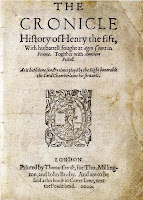 |
| Title page of Henry V from the first quarto (1600) |
What better way to celebrate St. George's Day (23 April), than in the company of Shakespeare and William Walton in the historic Temple Church. Temple Music Society put on a performance of William Walton's complete score from the Lawrence Olivier film of Henry V interleaved with speeches from the Shakespeare play to form a satisfying whole, allowing us to both hear the music in context and to experience the way that Walton's score interacts and supports the text. Walton's music was played by the Aurora Orchestra which was joined by the boy choristers from the choir of Temple Church, conducted by James Vivian who is music director of the Temple Church. The role of the narrator was taken by the actor John Hopkins and the whole directed by Kenneth Richardson.
Amazingly, despite being nominated for an Academy Award in 1946, William Walton's score for Lawrence Olivier's 1943 film of Shakespeare's Henry V had to be painstakingly reconstructed by Christopher Palmer. It seems astonishing that the original performing material would be disposed of, given the iconic status of the film. It was not only a striking filmic adaptation of the play, complete with Olivier's notable performance, but a piece of remarkable wartime propaganda.
Muir Matheson, who conducted the London Symphony Orchestra for the film, arranged an orchestral suite in 1963 and it is in this format that the score is best known. But this is to ignore the rest of the music and the way it interacts with the text.
For the performance in the Temple Church, Edward Watson's chamber version was used with the Aurora Orchestra numbering 11 players. The director Kenneth Richardson had selected the passages of the play spoken by John Hopkins, mainly using speeches by the Chorus and Henry himself, including most of the well known moment. Hopkins has acted for several years with the Royal Shakespeare Company and is currently rehearsing Titus Andronicus with them. But I am afraid that in my mind he will be long associated with the role of DS Scott in Midsomer Murders, though his performance as the narrator was thankfully a long way from the television role.
The performance opened in striking fashion with the boys processing through the church singing, to be followed by Hopkins striding down the nave declaiming the chorus's O for a muse of fire speech with the orchestra accompanying to create a very evocative melodrama. This was one of the strengths of the performance, the interleaving of music and text as melodrama, a forgotten and very powerful art.
Sight lines in the Temple Church are none too ideal for musical performance. But the acoustic was just right for the music, giving added colour and richness to the Aurora Orchestra's playing, at times it was difficult to believe that there were only 11 players. They clearly relished the vivid contrasts and varied colours that Walton uses. He raided both the Mulliner virginals book and the songs of the Auvergne for music, but the amazing thing is that the score does work and has Walton's consistent tint. The chamber orchestration uses both piano and harpsichord, plus plenty of percussion, and keeps the piquancy of Walton's writing.
The sequence was arranged into three parts, England, the Battle and France. Perhaps the most moving section of the first part was the conflation of the rejection of Falstaff (from Henry IV, part two) with Hopkins playing both Falstaff and Henry, with Walton's most moving music.
The Night Watch sequence in part two was similarly very effective, with the chorus's magical speech interwoven with Walton's musical sequence. The Agincourt music is probably the single most substantial piece in the score and one which stands alone without words. Olivier credited Walton's music with the making of the scene in the film, given the difficulties of filming during wartime. But to hear it preceded by Hopkins stirring rendering of This days is called the feast of Crispian was simply magical.
Part two ended with the boys processing in, this time singing Non nobis domine and they then joined the ensemble for the French scenes in part three. This was a most effective sequence, though perhaps not as striking as the battle scenes, or perhaps it was that Walton's use of the bailero from the Songs of the Auvergne did rather stand out. The Epilogue was again very effective both visually and dramatically, with the Hopkins declaiming the chorus's final speech as he strode out of the church, again with orchestral accompaniment.
The work lasted around an hour and made for a surprisingly satisfying whole. Hopkins impressed greatly with the way he welded the various speeches into a coherent hole. And the Aurora Orchestra and boy choristers contributed some vivid performances under James Vivian's direction. Not every film score deserves such treatment, but we are to be grateful to Temple Music for the opportunity to hear Walton's score again, performed in such stirring circumstances.
Elsewhere on this blog:
- Adventures at the Opera Awards
- Moto Perpetuo - CD review
- Gaelle Arques and James Baillieu recital
- Handel's L'Allegro
- Cherubini - Lodoiska - CD review
- Rustem Hayroudinoff recital
- Lawrence Brownlee - CD review
- Sunken Garden - ENO
- Veronique Gens and Julius Drake
- Alessio Bax plays Mozart - CD review
- CLoSer - Poulenc and Paris
- Giles Swayne - Stations of the Cross - CD review
- The Sixteen - Choral Pilgrimage
- Poeme d'un Jour -Ailyn Perez - CD review
- Charles Jennens: the man behind Handel's Messiah
- Home











No comments:
Post a Comment